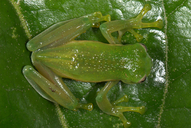|
Centrolene sabini Catenazzi, Von May, Lehr, Gagliardi-Urrutia & Guayasamin, 2012
Sabin's Glassfrog, Rana de cristal de Sabin | family: Centrolenidae subfamily: Centroleninae genus: Centrolene |
| Species Description: Catenazzi A, Von May R, Lehr E, Gagliardi-Urrutia G, Guaysamin JM 2012 A new, high-elevation glassfrog (Anura: Centrolenidae) from Manu National Park, southern Peru. Zootaxa 3388: 56-68. | |
 © 2013 Alessandro Catenazzi (1 of 3) |
|
|
|
Description Its coloration in life is green-yellowish, with yellowish patches and spots. Across its back, it is covered with yellowish-green tipped spicules. Its iris is silvery-bronze or cream bearing fine black reticulations. The bones are green (Catenazzi et al. 2012).
Distribution and Habitat Country distribution from AmphibiaWeb's database: Peru
Life History, Abundance, Activity, and Special Behaviors Trends and Threats The inaccessibility of this region makes it hard to assess. Comments
References
Catenazzi, A., Lehr, E., Rodriguez, L., and Vredenberg, V. (2011). ''Batrachochytrium dendrobatidis and the collapse of anuran species richness and abundance in the Upper Manu National Park, southeastern Peru.'' Conservation Biology, 5, 382-391. Catenazzi, A., Von May, R., Lehr, E., Gagliardi-Urrutia, G., Guayasamin, J.M. (2012). ''A new, high-elevation glassfrog (Anura: Centrolenidae) from Manu National Park, southern Peru.'' Zootaxa, 3388, 56-68. Originally submitted by: Michelle S. Koo (first posted 2012-07-29) Edited by: Michelle S. Koo (2012-07-29) Species Account Citation: AmphibiaWeb 2012 Centrolene sabini: Sabin's Glassfrog <https://amphibiaweb.org/species/7868> University of California, Berkeley, CA, USA. Accessed Jun 1, 2025.
Feedback or comments about this page.
Citation: AmphibiaWeb. 2025. <https://amphibiaweb.org> University of California, Berkeley, CA, USA. Accessed 1 Jun 2025. AmphibiaWeb's policy on data use. |


 Map of Life
Map of Life